Seat belt restraint system
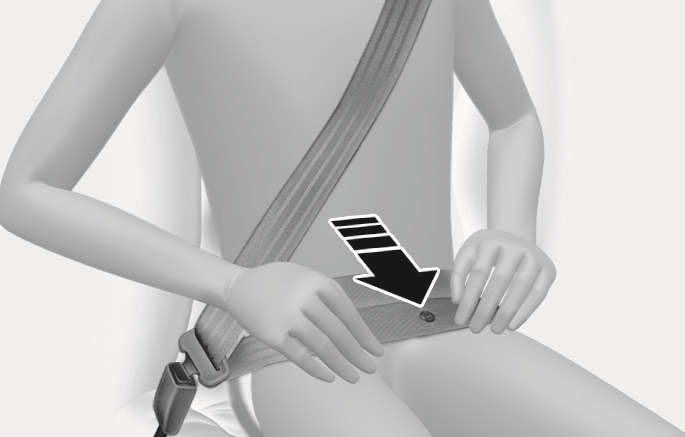
2C_SeatBeltWearStep_2
Improperly positioned seat belts may increase the risk of serious injury in an accident. Take the following precautions when adjusting the seat belt:
-
Position the lap portion of the seat belt as low as possible across your hips, not on your waist, so that it fits snugly. This allows your strong pelvic bones to absorb the force of the crash, reducing the chance of internal injuries.
-
Position one arm under the shoulder belt and the other over the belt, as shown in the illustration.
-
Always position the shoulder belt anchor into the locked position at the appropriate height.
-
Never position the shoulder belt across your neck or face.
To fasten your seat belt:
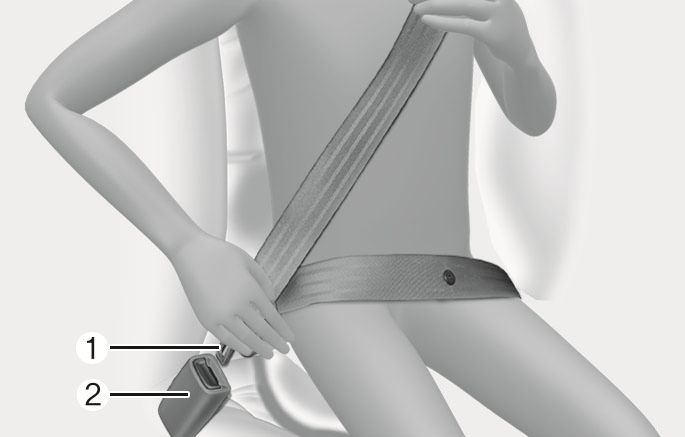
2C_SeatBeltWearStep
Pull it out of the retractor and insert the metal tab (1) into the buckle (2). An audible “click” sounds when the tab locks into the buckle. Make sure the seat belt is not twisted.
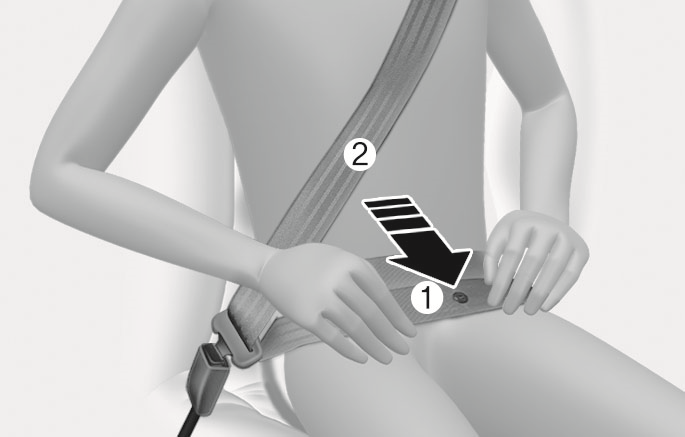
2C_SeatBeltCorrectWear
Place the lap belt (1) portion across your hips and the shoulder belt (2) portion across your chest.
The seat belt automatically adjusts to the proper length after the lap belt portion is adjusted manually so that it fits snugly around your hips.
If you lean forward in a slow, easy motion, the belt extends and moves with you. If there is a sudden stop or collision, the belt is locked in place. It also locks if you try to lean forward too quickly.
If you cannot smoothly pull the seat belt out from the retractor, firmly pull the seat belt out and release it. After release, the belt may be pulled out smoothly.
Height adjustment
Adjust the height of the shoulder belt so that it lies across your chest and midway over your shoulder nearest the door, not over your neck.
To adjust the height of the seat belt anchor:
-
Pull the height adjuster up (1) to raise the height. To lower it, push it down (3) while pressing the height adjuster button (2). Release the button to lock the anchor in place. Try pushing the height adjuster down to make sure that it is locked in place.
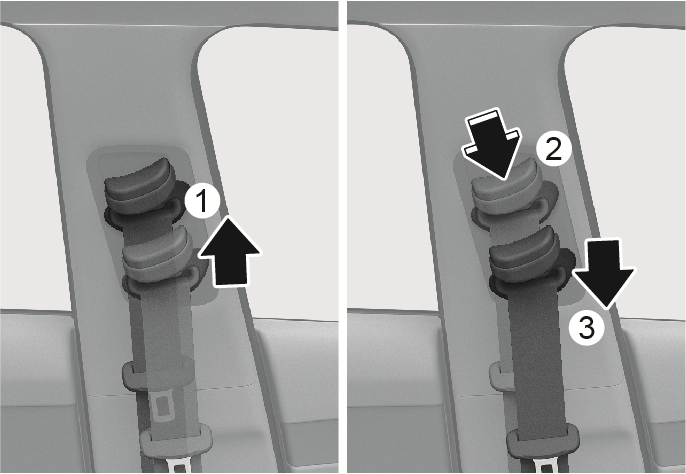
2C_AdjustSeatBeltHeight
To release your seat belt:
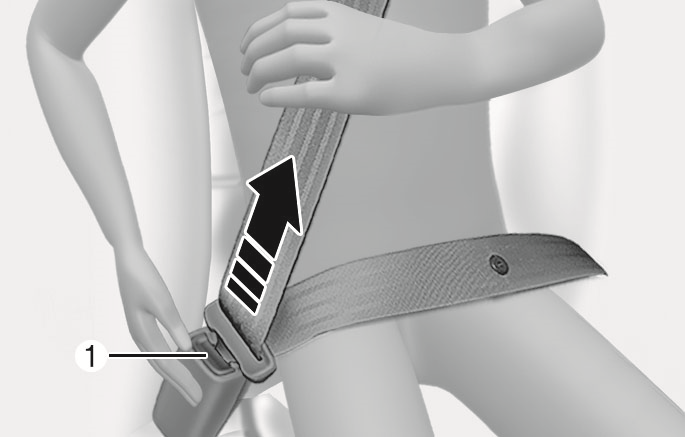
2C_SeatBeltRelease
Press the release button (1) in the locking buckle.
The belt should automatically draw back into the retractor. If this does not happen, check the belt is not twisted, then try again.
This type of seat belt combines both an emergency locking retractor and an automatic locking retractor. Convertible retractor type seat belts are installed in the rear seat positions to help accommodate the installation of child restraint systems.
A convertible retractor is also installed in the front passenger seat position, children should always be seated in the rear and never place any infant/child restraint system in the front seat.
To fasten your seat belt:
Pull the seat belt out of the retractor and insert the metal tab into the buckle. An audible “click” sounds when the tab locks into the buckle. Pull the shoulder portion of the belt to snug the belt across your hips and remove slack. Make sure the seat belt is not twisted.
When not securing a child restraint, the seat belt automatically adjusts to the proper length only after the lap belt portion of the seat belt is adjusted manually so that it fits snugly across your hips.
When the seat belt has been fully extended from the retractor to allow for the installation of a child restraint system, the seat belt operation changes to allow the belt to retract, but not to extend (Automatic Locking Retractor Type). For more information, refer to the "Child Restraint System (CRS)" section in this chapter.
To release your seat belt:

2C_SeatBeltRelease
Press the release button (1) in the locking buckle.
The belt should automatically draw back into the retractor. If this does not happen, check the belt is not twisted, then try again.
-
The emergency locking mode allows seated passengers to move freely in their seats while keeping some tension on the belt. During a collision or sudden stop, the retractor automatically locks the belt to help restrain the passengers.
-
To deactivate the automatic locking mode, unbuckle the seat belt and allow the belt to fully retract.
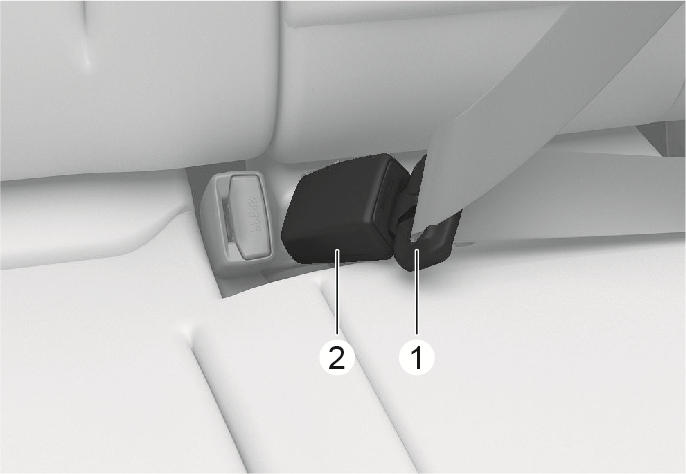
2C_RearCenterSeatBeltWearStep
Insert the tongue plate (1) into the buckle (2) until an audible “click" is heard, indicating the latch is locked. Pull the shoulder portion of the belt to snug the belt across your hips and remove slack. Make sure the seat belt is not twisted.
When using the rear center seat belt, use the buckle with the “CENTER” mark.
If you cannot pull out the safety belt from the retractor, firmly pull the belt out and release it. After release, pull out the belt smoothly.
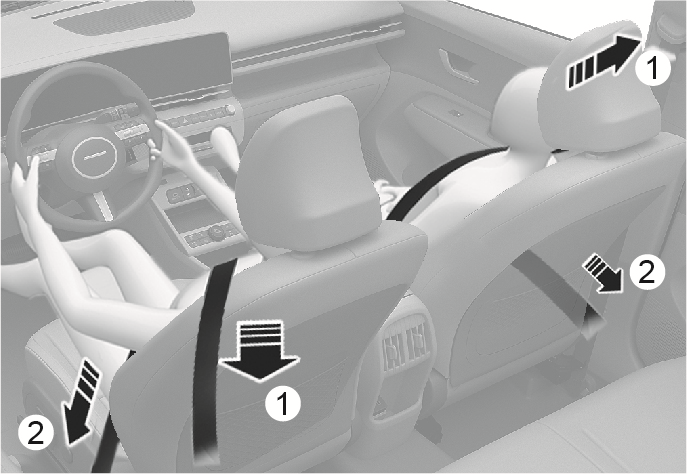
2C_RetractPretensioner
- Retractor pretensioner seat belt (Front seat and rear outboard seat)
- Emergency Fastening Device (EFD)
Your vehicle is equipped with driver’s and front passenger’s pretensioner seat belts (retractor pretensioner and Emergency Fastening Device) and rear passengers pretensioner seat belts (retractor pretensioner). The pretensioner makes sure the seat belts fit tightly against your body in certain frontal or side collision(s). The pretensioner seat belts may be activated in some crashes where the frontal or side collision(s) is severe enough, together with the airbags.
When the vehicle stops suddenly, or if you try to lean forward too quickly, the seat belt retractor locks in place.
In some frontal collisions, the pretensioner activates and pulls the seat belt against your body.
To prevent serious injury or death:
-
Always wear your seat belt and sit properly in your seat.
-
Do not use the seat belt if it is loose or twisted.
-
Do not place anything near the buckle.
-
Always replace your pretensioners after activation or an accident.
-
NEVER inspect, service, repair or replace the pretensioners by yourself. Have the pretensioners inspected, serviced, repaired, or replaced by an authorized HYUNDAI dealer.
-
Do not hit the seat belt assemblies.
Do not touch the pretensioner seat belt assemblies for several minutes after they have been activated. When the pretensioner seat belt mechanism deploys during a collision, the pretensioner can become hot and can burn you.
Body work on the front area of the vehicle may damage the pretensioner seat belt system. Have the system serviced by an authorized HYUNDAI dealer.

2C_PretensionerComponent
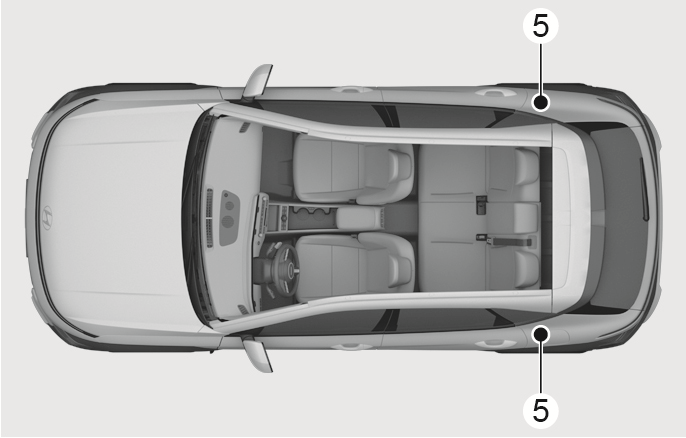
2C_RearRetractorPretensionerOverview
The pretensioner seat belt system consists mainly of the following components. Their locations are shown in the illustration above:
- SRS airbag warning light
- Retractor pretensioner (front)
- SRS control module
- Emergency Fastening Device (EFD)
- Retractor pretensioner (rear)
The sensor that activates the SRS control module is connected with the pretensioner seat belt. The SRS airbag warning light on the instrument cluster illuminates for about 3-6 seconds after the Engine Start/Stop button is in the ON position, and then turns off.
If the pretensioner is not working properly, the warning light illuminates even if the SRS airbag is not malfunctioning. If the warning light does not illuminate when starting the engine or stays illuminated or illuminates while driving, have the pretensioner seat belts and/or SRS control module inspected by an authorized HYUNDAI dealer as soon as possible.
-
Pretensioner seat belts may be activated in certain frontal or side collisions or rollover situations.
-
When the pretensioner seat belts are activated, a loud noise may be heard and fine dust, which may appear to be smoke, may be visible in the passenger compartment. These are normal operating conditions and are not hazardous.
-
Although it is non-toxic, the fine dust may cause skin irritation and should not be inhaled for prolonged periods. Wash all exposed skin areas thoroughly after an accident in which the pretensioner seat belts were activated.